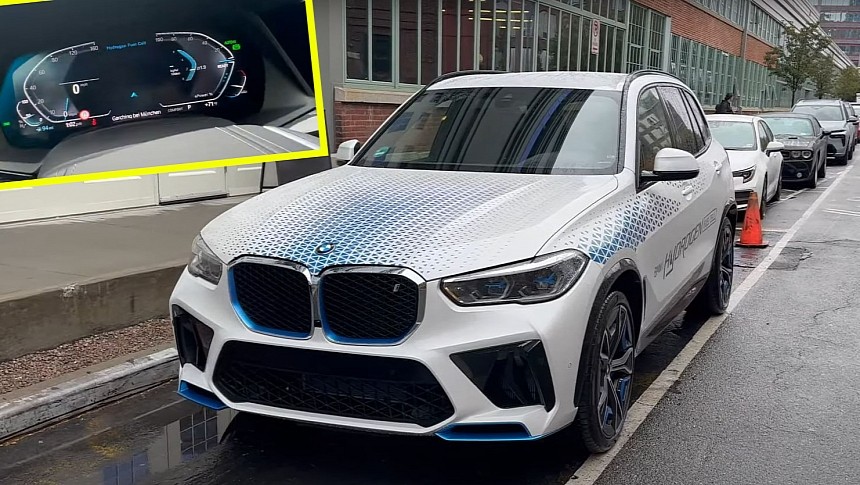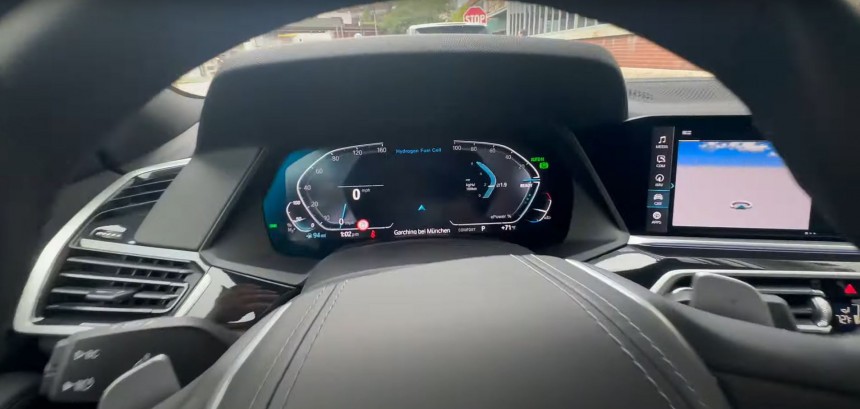Pairing a BMW shell with a Toyota-sourced powertrain can sound like a deal made in heaven. Who wouldn't like to have a car boasting great German design and Japanese dependability, right? The two brands worked together to make the iX5 Hydrogen – a fuel-cell all-electric vehicle that does not pollute the environment for personal mobility. But a brief experience with one shows the Bavarians have more work ahead of them. Range anxiety could be a thing.
Right now, the internal combustion engine is still king. Battery-electric vehicles like the Tesla Model Y, the Ford F-150 Lightning, or the Rivian R1S are growing in popularity. However, they are still no match for the fossil fuel-hungry powerplants hiding under the hood of freshly delivered cars. People like simplicity. Refueling at the pump is still easier than charging.
However, things are poised to change rapidly because Americans seem to be much more open to the idea of owning an all-electric vehicle nowadays. Tesla EVs are selling like hotcakes after the Texas-based brand applied hefty discounts. Gas prices going haywire is also contributing to EVs gaining more popularity. That's happening because Saudi Arabia and Russia decided to artificially limit the crude oil output and gas and diesel exports.
The EV narrative is further supported by the investments announced by the federal government in high-power charging infrastructure, the direct sales model that cuts out the middleman, automakers rallying around the NACS port and the Supercharger network, and the incentives available to qualifying individuals.
At the same time, cars are very expensive, and strikes at the Big Detroit Three might result in new delays or markups for popular models. So, when someone sees a non-Highland Tesla Model 3 available for just about $400 per month, it's hard not to sign the order agreement and take one home.
But some legacy automakers are not satisfied with battery-electric cars being the only solution for a sustainable future where mobility doesn't rely on burning crude oil derivatives. Toyota, for example, pushed forward with the Mirai, its fuel-cell electric vehicle (FCEV) that's a good-looking sedan. Hyundai made the Nexo crossover SUV.
Now, BMW's joining the contemporary H2 party with the iX5. But this is not their first hydrogen-powered rodeo. The German automaker experimented with this type of fuel all the way back in 1978 and even briefly put into production the 7 Hydrogen that retained its V12 mechanical beating heart.
The iX5 is not a battery-electric vehicle (yet), even though the name suggests it. However, unlike Toyota or Hyundai, the Bavarians take a more preemptive approach. They built under 100 units to test worldwide and give some customers or media representatives a taste of what life with an FCEV would be like.
By the looks of it, fuel economy might not be very good. A short New York drive revealed that the iX5 Hydrogen has a range of just 94 miles (151 kilometers) on half a tank. Fill it up with hydrogen "to the brim," and you could get around 190 miles (306 kilometers) of go on a full tank.
To put that figure better into perspective, a 2023 BMW i4 eDrive40 riding on 18-inch wheels has 301 miles of EPA-rated range, while a 2023 BMW iX xDrive50 with 20-inch wheels gets 324 miles.
What makes the iX5's range figure even weirder is that it has two large, highly-pressurized hydrogen carbon fiber-reinforced polymer tanks that can safely store six kilograms (13 pounds) of hydrogen. It was supposed to use 1.19 kg per 100 kilometers (2.62 lb per 62 miles). In this particular case, the consumption seems to be much higher.
However, it's not as bad as it may seem at first glance. Continue reading below to discover what we've recently learned.
UPDATE. BMW got in touch and provided useful explanations that better contextualized the figures expressed above. The iX5 Hydrogen checked out by Out of Spec's Kyle was used during the UN General Assembly week when traffic was horrendous in New York City.
As such, it was nearly impossible for the iX5 Hydrogen to return a satisfactory consumption figure or display its true efficiency capabilities. Moreover, real-world tests such as Autocar's that comprised driving in and out of the city revealed a range of 233 miles. That's 43 miles more than our estimation, which was based on the brief test drive conducted in NYC. So, the zero-emission SUV can do better!
It's also worth noting that BMW's WLTP-inspired measurements revealed a range of 313 miles.
At the same time, comparing this fuel-cell unit with battery-electric vehicles wasn't quite fair. Charging something like the BMW i4 takes longer than filling up with hydrogen. The sedan needs approximately 31 minutes to go from 10% to 80% state of charge when hooked to a high-power Level 3 stall. On the other hand, filling up the iX5's two carbon fiber reinforced plastic (CFRP) storage tanks with compressed hydrogen to should take three minutes maximum for a "top off."
In a scenario where filling up with hydrogen is as simple as is putting gas in your tank, that estimated 190-mile heavy traffic range provided by the current drivetrain implementation might not even matter all that much because the driver can just replenish the CFRP tanks in around 180 seconds.
Besides all that, the iX5 Hydrogen is an important prototype for BMW. It's not just an experiment, as we initially thought. The test units could pave the way for a series production version that will likely boast better technology, allowing it to be even more efficient. Such a development would align with BMW's plans to bring the sixth-generation eDrive to market through its "Neue Klasse" models.
For now, the iX5 Hydrogen prototypes use Toyota's fuel cell system and the fifth-generation eDrive tech. That recipe allows these FCEVs to generate a maximum output of 401 hp while leaving nothing but some droplets of water behind them.
When writing, hydrogen is expensive and not widely available in the US or Europe, except Germany where over 100 refueling stations exist. Still, there's hope that regulators will start taking sustainably-sourced hydrogen more serious. Their involvement is paramount for the success of this green drivetrain alternative.
As such, today's iX5 Hydrogen might not have the best range when it has to spend a ton of time in traffic, but BMW is capable of doing better and might bring forward a solution that changes the paradigm. We'll see what the future holds for hydrogen and the auto industry.
However, things are poised to change rapidly because Americans seem to be much more open to the idea of owning an all-electric vehicle nowadays. Tesla EVs are selling like hotcakes after the Texas-based brand applied hefty discounts. Gas prices going haywire is also contributing to EVs gaining more popularity. That's happening because Saudi Arabia and Russia decided to artificially limit the crude oil output and gas and diesel exports.
The EV narrative is further supported by the investments announced by the federal government in high-power charging infrastructure, the direct sales model that cuts out the middleman, automakers rallying around the NACS port and the Supercharger network, and the incentives available to qualifying individuals.
At the same time, cars are very expensive, and strikes at the Big Detroit Three might result in new delays or markups for popular models. So, when someone sees a non-Highland Tesla Model 3 available for just about $400 per month, it's hard not to sign the order agreement and take one home.
But some legacy automakers are not satisfied with battery-electric cars being the only solution for a sustainable future where mobility doesn't rely on burning crude oil derivatives. Toyota, for example, pushed forward with the Mirai, its fuel-cell electric vehicle (FCEV) that's a good-looking sedan. Hyundai made the Nexo crossover SUV.
Now, BMW's joining the contemporary H2 party with the iX5. But this is not their first hydrogen-powered rodeo. The German automaker experimented with this type of fuel all the way back in 1978 and even briefly put into production the 7 Hydrogen that retained its V12 mechanical beating heart.
The iX5 is not a battery-electric vehicle (yet), even though the name suggests it. However, unlike Toyota or Hyundai, the Bavarians take a more preemptive approach. They built under 100 units to test worldwide and give some customers or media representatives a taste of what life with an FCEV would be like.
To put that figure better into perspective, a 2023 BMW i4 eDrive40 riding on 18-inch wheels has 301 miles of EPA-rated range, while a 2023 BMW iX xDrive50 with 20-inch wheels gets 324 miles.
What makes the iX5's range figure even weirder is that it has two large, highly-pressurized hydrogen carbon fiber-reinforced polymer tanks that can safely store six kilograms (13 pounds) of hydrogen. It was supposed to use 1.19 kg per 100 kilometers (2.62 lb per 62 miles). In this particular case, the consumption seems to be much higher.
However, it's not as bad as it may seem at first glance. Continue reading below to discover what we've recently learned.
UPDATE. BMW got in touch and provided useful explanations that better contextualized the figures expressed above. The iX5 Hydrogen checked out by Out of Spec's Kyle was used during the UN General Assembly week when traffic was horrendous in New York City.
As such, it was nearly impossible for the iX5 Hydrogen to return a satisfactory consumption figure or display its true efficiency capabilities. Moreover, real-world tests such as Autocar's that comprised driving in and out of the city revealed a range of 233 miles. That's 43 miles more than our estimation, which was based on the brief test drive conducted in NYC. So, the zero-emission SUV can do better!
It's also worth noting that BMW's WLTP-inspired measurements revealed a range of 313 miles.
At the same time, comparing this fuel-cell unit with battery-electric vehicles wasn't quite fair. Charging something like the BMW i4 takes longer than filling up with hydrogen. The sedan needs approximately 31 minutes to go from 10% to 80% state of charge when hooked to a high-power Level 3 stall. On the other hand, filling up the iX5's two carbon fiber reinforced plastic (CFRP) storage tanks with compressed hydrogen to should take three minutes maximum for a "top off."
In a scenario where filling up with hydrogen is as simple as is putting gas in your tank, that estimated 190-mile heavy traffic range provided by the current drivetrain implementation might not even matter all that much because the driver can just replenish the CFRP tanks in around 180 seconds.
Besides all that, the iX5 Hydrogen is an important prototype for BMW. It's not just an experiment, as we initially thought. The test units could pave the way for a series production version that will likely boast better technology, allowing it to be even more efficient. Such a development would align with BMW's plans to bring the sixth-generation eDrive to market through its "Neue Klasse" models.
For now, the iX5 Hydrogen prototypes use Toyota's fuel cell system and the fifth-generation eDrive tech. That recipe allows these FCEVs to generate a maximum output of 401 hp while leaving nothing but some droplets of water behind them.
When writing, hydrogen is expensive and not widely available in the US or Europe, except Germany where over 100 refueling stations exist. Still, there's hope that regulators will start taking sustainably-sourced hydrogen more serious. Their involvement is paramount for the success of this green drivetrain alternative.
As such, today's iX5 Hydrogen might not have the best range when it has to spend a ton of time in traffic, but BMW is capable of doing better and might bring forward a solution that changes the paradigm. We'll see what the future holds for hydrogen and the auto industry.









